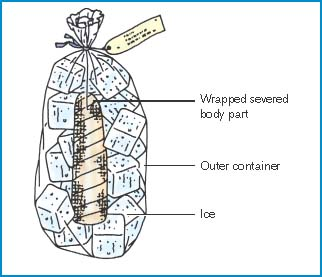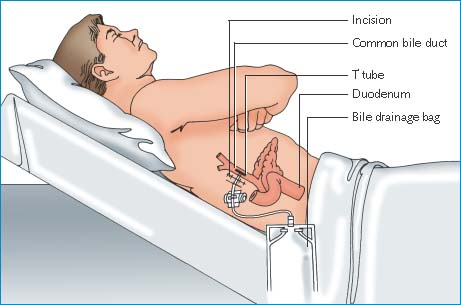T-Tube Care
The T tube (or biliary drainage tube) may be placed in the common bile duct after cholecystectomy, choledochostomy, or liver transplant and during treatment for cholelithiasis to promote biliary drainage.
The surgeon inserts the short end (crossbar) of the T tube in the common bile duct and draws the long end through the incision. The tube then connects to a closed drainage system. (See Understanding T-tube placement.) Postoperatively, the tube remains in place between 7 and 14 days—potentially longer after liver transplant. T-tube dressings are changed routinely, as ordered, to prevent infection and skin excoriation from bile drainage. The T-tube drainage bag should be emptied every 12 hours unless there’s significant drainage or a specific doctor’s order. In preparation for removal, the tube may be clamped to assess the patient’s tolerance to the return of bile flow and to aid in digestion.
Caring for A Severed Body Part
After traumatic amputation, a surgeon may be able to reimplant the severed body part through microsurgery. The chance of successful reimplantation is much greater if the amputated part has received proper care.
If a patient arrives at the health care facility with a severed body part, first make sure that bleeding at the amputation site has been controlled. Then follow these guidelines for preserving the body part.
Perform hand hygeine.2,3,4 Put on sterile gloves. Place several sterile gauze pads and an appropriate amount of sterile roller gauze in a sterile basin, and pour sterile normal saline or sterile lactated Ringer’s solution over them. Never use any other solution, and don’t try to scrub or debride the part.
Holding the body part in one gloved hand, carefully pat it dry with sterile gauze. Place saline-moistened gauze pads over the stump; then wrap the whole body part with saline-moistened roller gauze. Wrap the gauze with a sterile towel, if available. Then put this package in a watertight container or bag and seal it.
Nursing Alert
Don’t oversoak the gauze because the body part may become macerated.
Fill another plastic bag with ice and water to make an ice-water slurry and place the part, still in its watertight container, inside. Seal the outer bag. (Always protect the part from direct contact with ice—and never use dry ice—to prevent irreversible tissue damage, which would make the part unsuitable for reimplantation.) Keep this bag ice-cold until the doctor is ready to do the reimplantation surgery.
Label the bag with the patient’s name, identification number, identification of the amputated part, the health care facility’s identification number, and the date and time when cooling began.
Note: The body part must be wrapped and cooled quickly. Irreversible tissue damage occurs after only 6 hours at ambient temperature. However, hypothermic management seldom preserves tissues for more than 24 hours.
 |
Equipment
Clean gloves ▪ small plastic bag ▪ sterile gloves ▪ sterile 4″ × 4″ gauze pads ▪ transparent dressing ▪ normal saline solution ▪ sterile skin cleaning solution ▪ two sterile basins ▪ antiseptic pads ▪ sterile precut drain dressings ▪ hypoallergenic paper tape ▪ skin protectant, such as petroleum jelly, zinc oxide, or aluminum-based gel ▪ clamp or rubber band ▪ clean gauze ▪ graduated collection container.
Implementation
Verify the doctor’s order and check the patient’s medical recorder for a history of allergies.
Gather all necessary equipment at the bedside. Label all solution containers and a reusable collection container with the patient’s name and date.

Stay updated, free articles. Join our Telegram channel

Full access? Get Clinical Tree


Get Clinical Tree app for offline access

